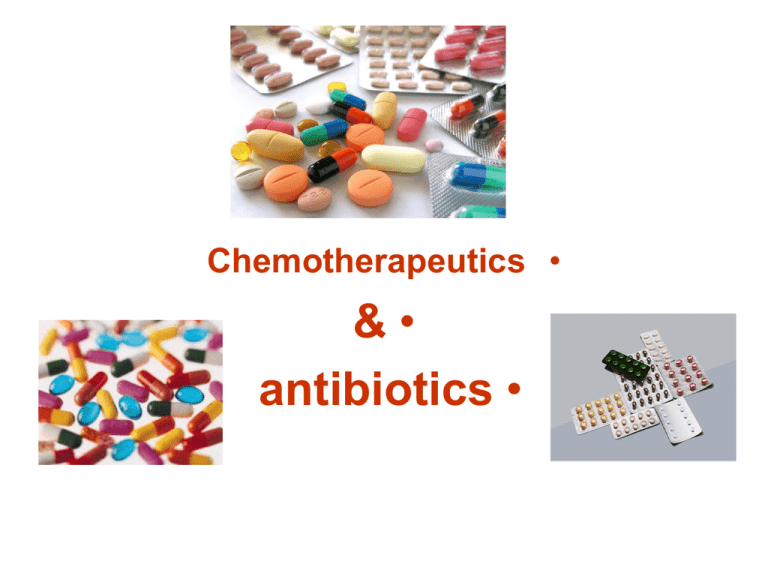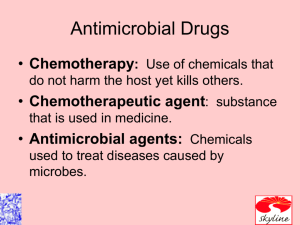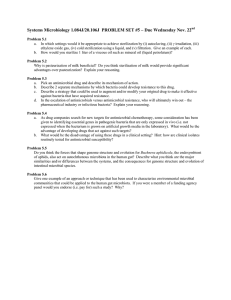• & antibiotics Chemotherapeutics
advertisement

Chemotherapeutics • &• antibiotics • Chemotherapeutics Chemicals which are used within the body • tissues to kill or inhibit the growth of pathogenic organisms The Spectrum of antimicrobial Activity **it is easy to find or develop drugs that • effective against prokaryotic cells ,& that do not affect the eukaryotic cells of humans **the problem is difficult when the • pathogen is eukaryotic (fungus, protozoan, helminthes) **viral infection more difficult to treat • The Spectrum of antimicrobial Activity Prok.**-differ in cell wall • -differ in fine structure of their • ribosome -details of their metabolism • Euk.**resemble the human cell • **the virus is within the human cells • antibiotics Antibiotics=are a metabolic products or a constituent of a microorganism which kills or inhibit the growth of another microorganism Nowadays used are semi synthetic (Ampicillin) synthetic (Sulfa drugs) or (produced wholly or partly by chemical synthesis) Low concentrations inhibit the growth of m.o. 7 Characteristics of a good chemotherapeutic or antibiotic 1-it must kill or inhibit the growth of the pathogenic organism 2-it must cause no damage to the host (it must have • selective • toxicity) 3-it must cause no allergic reaction • 4-it must be stable in solid or dissolved state • 5-it must remain in the desired tissue for the sufficient length of time (pharmacokinetics) 6- it must kill the pathogenic organism becomes resistant to the drug quickly before it mutates and • • Pharmacokinetics have to be desirable • (absorption, disintegration) selective toxicity = toxic for the • pathogenic organism and not toxic for the host == defined by the therapeutic index max. tolerated dose (toxic to the host) • -------------------------------------------------------------- • min. curative dose (effective therapeutic dose) • The high the therapeutic index the better the • antibiotic is Drug Dosage (per Kg Body Weight) Therapeutic Index = Toxic Dose/Therapeutic Dose Small Ratio (dangerous) Moderate Ratio High Ratio (safe) Most desirable. 10 Antibiotics activity The Spectrum of antimicrobial Activity Narrow spectrum = affect only select group of microorganisms e.g Penicillin Gaffects Gram positive bacteria • • Broad spectrum = affect a broad range of • Gram positive or Gram negative bacteria = affect a more diverse • range of microbes • e.g. Chloramphenicol. Antibiotics activity The type of activity Bactericidal : direct killing of microorganisms • = kill microorganisms directly • (Streptomycin) • Bacteriostatic = inhibit their growth • = prevent microorganism • from growth (chloramphenicol) • #*#* =Host defenses usually destroy microorganisms by phagocytosis & antibody production Combination of • Mechanisms of Antimicrobial Action • Bacteria have their own enzymes for – Cell wall formation – Protein synthesis – DNA replication – plasma membrane – Synthesis of essential metabolites 17 Bacterial protein synthesis inhibitors ## initiation of protein synthesis • ## elongation (=interfere with elongation factors) • Fusidic acid Bacteriostatic Gm+ve bacteria only initiation of protein synthesis inhibitors Antimicrobial that bind to the 50S ribosomal subunit Antimicrobial that bind to the 30S ribosomal subunit bacteriostatic Aminoglycosides Chloramphenicol – Tetracyclines broad rang bacteriostatic Lincomycin Clindamycin Restricted range Macrolides Gm+ve bacteria & Mycoplasma Erythromycin broad spectrum Tetracyclin, Minocycline Doxycycline Bactericidal Many gm.-ve bacteria &some gm+ve. Bacteria Streptomycin Kanamycin Gentamycin Neomycin Tobramycin Inhibitors of nucleic acid synthesis & function Inhibitors of RNA Inhibitors of DNA (DNA dependent RNA polymerase) (DNA gyrase) Rifampin Quinolones Rifamycin Nalidixic acid Rifampicin Ciprofloxacin Bactericidal Bactericidal Wide spectrum Tuberculosis Gm+ve bacteria urinary tract infection Bacterial cell wall synthesis inhibitors • Bacterial cell wall synthesis inhibitors (bactericidal) penicillins Bactericidal • Narrow range • Effected by Stomach • acidity=intramuscularly Susceptible to penicillinase (b • lactamase) = are enzymes produced by many bacteria (Staph.) that clave the b lactam ring • Methicillin • Oxacillin • Ampicillin & amoxacillin & • Mezlocillin=broad spectrum Carbapenems & Monobactam =broad • • Cephalosporins=gm-ve • Vancomycin Bacitracin =gm+ve ++ anti mycobacterial agents • Mycobacterium tuberculosis • • Antibiotics that interfere with mycolic acid synthesis or incorporation – Isoniazid (INH) – Administerd simultaneously with other drug (rifampin=rifampicin) Plasma membrane= phospholipids & • protein Polymixin B interfere with phospholipids • of plasma membrane Bactericidal • Gm. – ve bacteria • Antimetabolite antimicrobials ++ Inhibitors of folic acid synthesis • (bacteria cannot use pre-formed folic acid, they • synthesize their own folic acid) bacteriostatic antifungal • Antifungal chemotherapeutics Fungi are Eukaryotes • They may be unicellular ( yeast) or • multicellular (mold). Cell wall compose of chitin • Sterols in plasma membrane = ergosterol • Antifungals Macrolide Polyenes Amphotericin B –mimic lipids, most versatile & effective, topical & systemic treatments Nystatin – topical treatment Azole • Synthetic azoles – broad-spectrum; • ketoconazole, clotrimazole, miconazole (topical treatment of athlets foot) Allylamine • Recently developed antifungal=inhibit • ergosterols Antifungal drugs • Flucytosine – analog of cytosine; coetaneous mycoses or in combination with amphotericin B for systemic mycoses • **interfere with RNA biosynthesis 44 Antiviral drugs • Antiviral drugs Attachment • Penetration • Uncoating • Nucleic acid synthesis (polymerases inhibitors) • Assembly • release • Nucleoside & nucleotide analoges • (acyclovir, ribavirin, lamavudine) • Lamavudine ==nucleoside analog=cytidine • Hepatitis B virus • Reverse transcriptase inhibitor==HIV • Antiviral drugs Acyclovair=Zovirax=acycloguanosine=ACV Guanosine analogus **Herpes simplex virus infection (Genital, oral & eye) **varicilla zoster virus (Shingles & Chickenpox in immunocompromised patients) ###viral thymidine kinase phosphorelate the drug ==this inactivate DNA polymerase @@activity only inside virally infected cells@@ Ribavirin==guanosin analoge • stop viral RNA synthesis & mRNA • ===nucleoside inhibitor • ***hepatitis C virus • ***respiratory syncytial virus • Amantadine ==symmetrel • ***uncoating of influenza virus • Tamiflue…..neuraminidase • HIV inhibitors • Reveres transcriptase enzyme • inhibitors=retrovirus= nucleoside analoge Protease inhibitors • (Indinavir, saquinavir, ritonavir) • Zidovidine=rv.tr. inhibitor • Antiviral Drugs Interferon=protein(cytokines) produced by virally infected cells, that inhibit spread of the virus & protect other cells ***by the activation of the cell to produce certain enzyme ==prevent viral protein synthesis ==kill virally infected cells ==the same way in which cancer cells be killed (cancers) • (Viral hepatitis) 52 Anti protozoa chemotherapeutics• Protozoa are unicellular Eukaryotic microbes • Have variety of shapes, • Lives free or as parasite • They absorb or ingest organic compounds from • their environment Anti malaria • Malaria is an entirely preventable & • treatable disease treatment==rapid & complete • elimination of the parasite ------chronic & anemia prevention== of the spread & emerging • resistance Drugs used for malaria prophylaxis can work in one of three ways: Kill parasites in the liver Causal prophylaxis primaquine ++++ malarone ++ Mosquito Human Kill sexual parasites (gametocytes) in RBCs Gametocytocidal prophylaxis primaquine ++++ Kill asexual parasites in RBCs Suppressive prophylaxis chloroquine ++++ malarone ++++ mefloquine ++++ doxycycline ++++ 56 Antihelminthic Drugs Praziquantel Albendazole Surgery 57 • Helminths are macroscopic multicellular eukaryotic organisms: tapeworms, roundworms, pinworms, hookworms Clinical uses of antimicrobial drugs Clinical uses of antimicrobial drugs Inappropriate Antimicrobial Use • Prescription not taken correctly Antibiotics for viral infections Antibiotics sold without medical supervision Spread of resistant microbes in hospitals due to lack of hygiene Proper selection of antimicrobial agent is based on a number of factors **-the identity of the pathogen • **-potential toxicity to the patient • **-pharmacokinetics & pharmacodynamics of • the agent **-site of infection • **-rout of administration • **-drug resistance • **-possible drug interaction • **-host factors • **-cost • Drug selection should be based on it’s • activity against infecting pathogen pathogen may be predictably susceptible • to a particular drug Therefore lab. guidance is essential for • safe prescribing Culture & sensitivity test • Susceptibility Tests (cont’d) Agar diffusion = disk-diffusion test Kirby-Bauer Disk Diffusion Test Sensitive Intermediate resistant 62 Minimal Inhibitory Concentration (MIC)=the lowest concentration of drug capable of preventing bacterial growth vs. Minimal Bactericidal Concentration (MBC)=the lowest concentration of chemotherapeutic agent that kills bacteria 32 ug/ml 16 ug/ml 8 ug/ml Sub-culture to agar medium 4 ug/ml 2 ug/ml 1 ug/ml MIC = 8 ug/ml MBC = 16 ug/ml Minimum inhibitory concentration • (MIC) is determined when • **a patient does not respond to treatment • **thought to be adequate, • **relapses while being treated • .**when there is immunosuppression • Host factors play an important part in proper selection of antimicrobial drug **-age • **-circulating & tissue phagocyte activity • e.g. hematological malignancy=acute • leukemia Bactericidal= amino glycosides • broad spectrum penicillins • cephalosporin • quinolones • Pharmacological factors By achieving satisfactory drug concentration at the site of infection Standard pharmacokinetics =absorption • distribution • metabolism • excretion • Oral---- G.I. absorption should be satisfactory • interaction with food • vomiting (surgery) • ***Parenteral agent will be required • • Site of infection ---lipid solubility of the drug • Amino glycosides are poorly lipid –soluble • =penetrate CSF poorly (bacterial meningitis) Meningeal inflammation also affect drug • penetration into the tissues Beta-lactam agents achieve satisfactory • concentration within CSF but the inflammation subsides drug concentration super infection Normal flora (skin & mucous membrane) • Microbial overgrowth of resistant pathogen • Oral & vaginal candidiasis • Broad spactrum-(ampicillin or tetracycline) • Pseudo-membranous colitis • Toxin-producing strain of clostridium • Following the use of clindamycin • Managed by oral vancomycin • surgery • Proper selection of antimicrobial agent is based on a number of factors **-the identity of the pathogen • **-potential toxicity to the patient • **-pharmacokinetics & pharmacodynamics of • the agent **-site of infection • **-rout of administration • **-drug resistance • **-possible drug interaction • **-host factors • **-cost • Drug resistance Intrinsic= inherent properties of bac. are • responsible for preventing antibiotic action ==always chromosomally mediated 0r • Acquired= occurs when bac. which were • previously susceptible then become resistance == occur by mutation in the chromosome or by • acquisition of genes coding for resistance from external source (plasmid) Plasmid mediated resistance has been • recognized among Gm.-ve bact.== can code for multiple resistant ##cephalosporins, chloromphinicol, amino glycosides ==enzymatic inactivation • hospitals & intensive care units • Multi-drug resistance Methicillin resistant Staph.aureus (MRSA) • =resist to many antibiotics • Hospitals, intensive care units, burn • ,cardiothoracic units Glycopeptides , vancomycin • Mechanisms of Antibiotic Resistance Enzymatic destruction of drug (B lactamase) Drug inactivation – penicillinases Prevention of penetration of drug to its target site within the bacteria (tetracycline resistance) Decreased permeability to drug or increased elimination of drug from cell 74 Mechanisms of Antibiotic Resistance Alteration of drug's target site(a.a changes in the ribosome) Change in metabolic patterns Rapid ejection of the drug Change in drug receptors Efflux pump= antibiotic is rapidly extracted from • the cell by an energy-dependent mechanism ( tetracyclines & macrolides) ++ Inpaired cell wall or cell envelope • penetration ++ Enzymatic inactivation • ++ Altered binding sites • ++ Efflux pump= antibiotic is rapidly • extracted from the cell by an energy-dependent mechanism( tetracyclines & macrolides) What Factors Promote Antimicrobial Resistance? Exposure to sub-optimal levels of antimicrobial Exposure to microbes carrying resistance genes 79 To lower Antimicrobial Resistance Development • Use more narrow spectrum antibiotics • Use antimicrobial cocktails Effects of combinations of drugs • Synergism Penicillin and streptomycin, Sulfa and trimethoprim • Antagonism Penicillin and tetracycline • 80 Addition Combination of Drugs For antibiotics “A” and “B” used in combination: 81 Actual killing rate = A + B Additive Actual killing rate > A + B Synergistic Actual killing rate < A + B Antagonistic Typically bacteriostatic agents are antagonistic to bactericidal agents. Bacteriocidal agents can be synergistic (think of the latter as one antibiotic weakens more bacteria than it kills, making the not-killed bacteria more susceptible to additional insult by the second antibiotic). Additive means that the two (or more) antibiotics neither hinder nor help each other’s ability to kill. Also relevant to rates of mutation to resistance. Second term exam. • Good luck •





